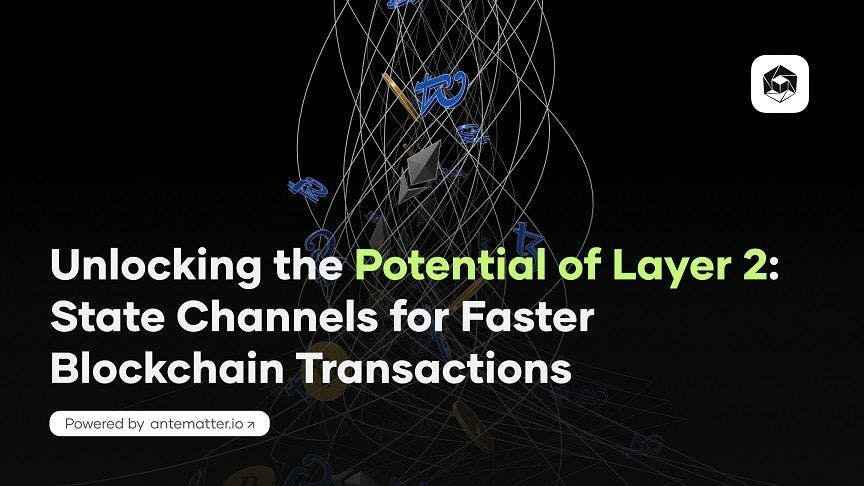Unlocking the Potential of Layer 2 State Channels for Faster Blockchain Transactions
Explore how Layer 2 State Channels can transform blockchain transactions by enhancing speed, reducing costs, and increasing scalability. This guide delves into the mechanics and advantages of State Channels, offering businesses a practical solution to overcome the inherent limitations of Layer 1 blockchains like Bitcoin and Ethereum.

Layer 2 blockchain technologies have emerged as a powerful solution to the scalability challenges faced by many Layer 1 blockchains like Bitcoin and Ethereum. Layer 1 blockchains, which form the base layer of the blockchain technology stack, are often constrained by limitations in transaction processing speed and scalability.
Understanding Layer 2 Blockchain Solutions
Layer 2 blockchain solutions are protocols that operate on top of a Layer 1 blockchain (the main blockchain) to enhance its scalability and efficiency. These solutions process transactions off the main blockchain (off-chain) and then record the final state on the main blockchain. By doing so, they significantly reduce the burden on the main chain, allowing for faster transaction speeds, lower costs, and increased scalability. Layer 2 solutions are varied and include State Channels, Rollups, Sidechains, and Plasma, among others.
State Channels: A Deep Dive
State Channels are a type of Layer 2 scaling solution that allows users to interact with each other directly off-chain in a secure and efficient manner, with the blockchain only being used to record the final state of their interactions. This method is highly efficient as it minimizes the need for on-chain transactions, thereby reducing congestion and fees on the main blockchain.
How State Channels Work
- Opening a channel: Two or more parties agree to open a state channel by submitting an initial state to the blockchain. This action requires an on-chain transaction.
- Off-chain interactions: Once the channel is open, the parties can perform any number of transactions between themselves off-chain. These transactions are not submitted to the main blockchain, allowing for instant settlements and minimal transaction fees.
- Closing a channel: The channel can be closed by any participating party. Closing the channel involves submitting the final state of all off-chain transactions to the main blockchain. This final state is then recorded on-chain, requiring only one transaction regardless of the number of off-chain transactions made.
How Off-chain Transactions Work
Offline transactions in the context of Ethereum and other blockchains offer a way to sign transactions without directly connecting to the internet, enhancing security, especially for high-value transactions. One method for creating offline transactions involves using Ethereum's Typed Data v4 (EIP-712), which allows for human-readable hash signing.
Here’s a step-by-step example:
Preparing Typed Data v4 (EIP-712) for Offline Signing
Step 1: Define the Data to Sign
The first step is defining the data you wish to sign. This involves creating a JSON object that includes types, the primary type, domain, and the message itself.
{
"domain": {
"chainId": 1,
"name": "Example DApp",
"verifyingContract": "0xCcCCccccCCCCcCCCCCCcCcCccCcCCCcCcccccccC",
"version": "1"
},
"message": {
"contents": "Hello, Bob!",
"from": {
"name": "Alice",
"wallets": ["0x...", "0x..."]
},
"to": [
{
"name": "Bob",
"wallets": ["0x...", "0x..."]
}
]
},
"primaryType": "Mail",
"types": {
"EIP712Domain": [
{ "name": "name", "type": "string" },
{ "name": "version", "type": "string" },
{ "name": "chainId", "type": "uint256" },
{ "name": "verifyingContract", "type": "address" }
],
"Mail": [
{ "name": "from", "type": "Person" },
{ "name": "to", "type": "Person[]" },
{ "name": "contents", "type": "string" }
],
"Person": [
{ "name": "name", "type": "string" },
{ "name": "wallets", "type": "address[]" }
]
}
}
Step 2: Serialize the Data
Serialize the JSON object so it can be signed. This is usually handled by the library you're using to interact with Ethereum, like web3.js or ethers.js.
Step 3: Sign the Data
Use a signing tool or library function to sign the serialized data. If you're doing this offline, you'll typically use a hardware wallet or a software wallet that supports offline transaction signing.
For web3.js, you might use:
web3.eth.accounts.sign(dataToSign, privateKey);
For ethers.js, the process might look like:
const signer = new ethers.Wallet(privateKey);
const signature = await signer.signMessage(ethers.utils.arrayify(dataToSign));
Step 4: Transmit the Signed Transaction
Once the data is signed, the resulting signature needs to be transmitted to someone with internet access or directly to the Ethereum network, if momentarily going online is an option. This can be done by generating a raw transaction that includes the signature, then broadcasting it to the Ethereum network via a gateway or a connected online service.
Example using ethers.js:
const signedTx = await signer.signTransaction(transactionRequest);
const txResponse = await provider.sendTransaction(signedTx);
Step 5: Broadcast the Transaction
The final step is broadcasting the signed transaction to the Ethereum network. This usually involves an online Ethereum node or service like Infura, Alchemy, or a wallet interface.
provider.send('eth_sendRawTransaction', [signedTx])
.then((txHash) => console.log(`Transaction hash: ${txHash}`))
.catch((error) => console.error(`Error broadcasting transaction: ${error.message}`));
Advantages of State Channels
- High Throughput: State channels can process a large number of transactions between parties off-chain, significantly increasing the transaction throughput.
- Instant Transactions: Transactions within a state channel are settled instantly, improving the user experience.
- Reduced Costs: By minimizing the number of transactions that need to be recorded on the main blockchain, state channels reduce transaction fees.
- Privacy: Since transactions are processed off-chain, state channels can offer greater privacy than on-chain transactions.
Conclusion
Layer 2 blockchain solutions like state channels offer a promising path to overcoming the scalability challenges faced by Layer 1 blockchains. By enabling efficient off-chain transactions while leveraging the security and finality of the underlying blockchain, state channels and other Layer 2 technologies are crucial for the continued growth and adoption of blockchain applications across various industries.